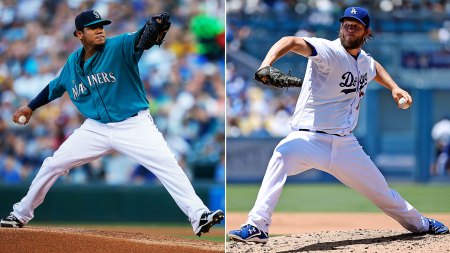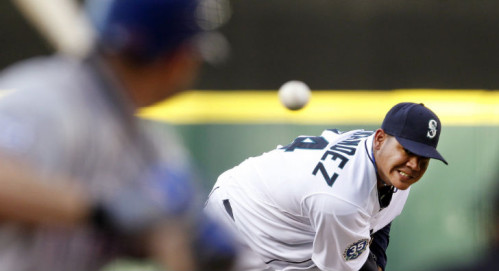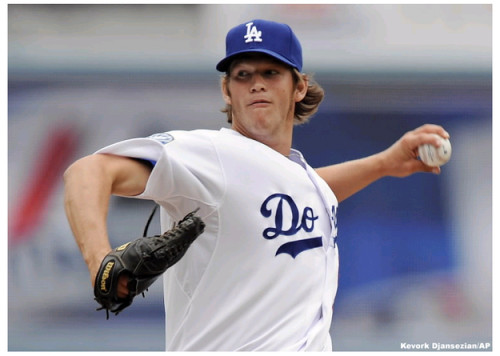Growing up in the 1990’s was a time to enjoy supreme power in baseball – it was the reign of sluggers like Bonds, Sosa, McGwire, Thomas, McGriff, Bagwell, Vaughn (two of them), and dozens of others. Yet, at the same time, the pitching was filthier than ever – pitchers such as Clemens, Maddux, Glavine, Smoltz, Johnson, and Martinez either came of age or thrived as never before. Their success lasted into the 2000’s, but while we were treated to a new crop of sluggers (Pujols, Konerko, Giambi, Ortiz, etc.), the pitching of the era never really developed the kinds of aces we saw in the 90’s.
Sure, there were good pitchers, but many of them only thrived for a short window of time. Just scrolling through the Cy Young winners of the 2000’s reveals a laundry list of pitchers who thrived for one or two season before either rapidly aging (Roy Halladay, who I still firmly believe is a Hall of Famer, Chris Carpenter), getting injured with depressing frequency (Johan Santana, Brandon Webb Carpenter again), or losing their stuff and became remarkably ineffectual (Tim Lincecum, Barry Zito, and potentially Justin Verlander). Or they just took steroids. (Eric Gagne and Roger Clemens, I’m looking at you.)
Fortunately for those who love great pitching, we’ve entered a Renaissance (of sorts). The days of dominant pitchers winning 20 games year after year is over, but the quality of the pitching hasn’t changed from the greats who took their turns every five days in the 90’s. A quick survey of the pitching leaderboards in either league reveals such names as Johnny Cueto, Adam Wainwright, David Price, Corey Kluber, and Chris Sale.
However, there are two pitchers in particular who stand heads and tails above their competition, even in this pitching dominant era, two undisputed aces who are pitching their teams into the thick of the postseason races.
Felix Hernandez
| W | L | ERA | G | GS | CG | SHO | SV | SVO | IP | H | R | ER | HR | HB | BB | IBB | SO | AVG | WHIP | GO/AO | |
|---|---|---|---|---|---|---|---|---|---|---|---|---|---|---|---|---|---|---|---|---|---|
| 2014 Stats | 13 | 4 | 1.99 | 26 | 26 | 0 | 0 | 0 | 0 | 185.1 | 130 | 49 | 41 | 8 | 4 | 32 | 0 | 197 | .195 | 0.87 | 1.64 |
For ten years now, King Felix has toiled away in the pitching friendly confines of Safeco Field in Seattle. For ten years, he has produced sterling results, with over 2000 innings pitched, nearly 300 games started, and almost 2000 strikeouts. And for ten years, he has gone without even sniffing the postseason. Hopefully, that will not be the case this year, as the Mariners are fighting tooth and neck for one of the two AL Wild Card slots. A revamped offense led by Robinson Cano certainly helps, but the real driving force is the pitching staff, led by Hernandez.
A comebacker to the mound caused a hip injury to Felix in his game on August 16, which ended a streak of 16 games pitched where he went at least seven innings and allowed two runs or less. For comparison’s sake, the record was previously held by Hall of Famer Tom Seaver. Even expanding the conditions to be two earned runs or less, the record was 15 games, held by Hall of Famer Gaylord Perry. (Noticing a trend?)
The one stat to look at in the above table is WHIP, which is the number of Walks plus Hits per Innings Pitched that a pitcher gives up. A good pitcher has something around 1.2 to 1.3. Anything below 1 is impressive. Felix’s WHIP of 0.87, as it stands, would be the lowest of his career…and he’s just 28 years old, entering his prime. Another stat to consider is his strikeout to walk ratio, which currently sits at 6.15/1. That’s a sign of effective control. (His low home run total, while impressive, is negated somewhat by the fact that he pitches at the cavernous Safeco.) The added offense has only increased his effectiveness. The “win” stat has become devalued in modern times in part because of how good King Felix has been with a mediocre offense behind him – countless times in the past, he’s pitched brilliantly only to take a loss because he gave up two to three runs while his offense scored only once or twice.
His change-up, perhaps the King’s most effective pitch, has been so devastating this year that hitters have managed only 23 hits out of 797 thrown. That’s 2.9% of the time, for the record, or a batting average against of .020. Dominance doesn’t begin to do justice.
As far as long term projections go, Felix is, again, just entering his prime. With a career WAR total of 45.0 to date, another five or so years of high caliber pitching (injuries notwithstanding), would put him in range of the average Hall of Fame pitchers. (For reference, the average HOF pitcher has a WAR of 73.4.) Pay attention to this man – he’s probably one of the top three pitchers of our generation.
Clayton Kershaw
| W | L | ERA | G | GS | CG | SHO | SV | SVO | IP | H | R | ER | HR | HB | BB | IBB | SO | AVG | WHIP | GO/AO | |
|---|---|---|---|---|---|---|---|---|---|---|---|---|---|---|---|---|---|---|---|---|---|
| 2014 Stats | 14 | 3 | 1.86 | 20 | 20 | 6 | 2 | 0 | 0 | 145.1 | 103 | 30 | 30 | 8 | 1 | 19 | 0 | 174 | .198 | 0.84 | 1.63 |
Initially heralded as the second coming of Sandy Koufax (how many times has that been bandied about?), Kershaw has all but fulfilled his expectations, indeed surpassing them in several regards. Consider the following:
- In his last start, he gave up two home runs for the first time this year, and still pitched a complete game with 11 strikeouts.
- His WHIP has decreased for the third year in a row to a microscopic 0.84.
- He threw a no-hitter this year that had the second highest game score (a record of how effective a pitcher’s start is) in history. (At 102, it sits behind Kerry Wood’s 20-K game in 1998, which scored at 105).
- He had a scoreless innings streak this year of 41 games, or about 20% of an average starting pitcher’s season.
- His ERA has been under 2.00 for the past 100+ games (somewhere around 102). The only other pitcher to do that was Greg Maddux at the height of the 90’s, a streak that lasted for 144 games.
- Remember Felix’s K/BB rate of 6.15? Kershaw’s is 9.16. His K/9 rate (Strikeouts per 9 innings) 10.78.
His above stats come after missing the first month of the season. Had he pitched to expectations in April and not been hurt, he’d be a shoo-in for the Cy Young. As it stands, he’s currently standing somewhere in perpetual second place as Johnny Cueto and Adam Wainwright circle each other. (I’ll be honest and state that while I am in awe of Kershaw, if he were to lose to Cueto, I wouldn’t be the saddest person in the room.)
After seven years (only seven!) of stellar pitching, Kershaw sits at 39.4 WAR, a number which continues to climb. Kershaw is only 26, and close to 100 wins already (he’ll pass it next year). The man already has two Cy Young awards, and possibly could have won a third in 2012 (though R.A. Dickey was a deserving winner that year). If he continues to pitch as he has for another seven years, we won’t just be looking at a Hall of Fame pitcher. We’ll be looking at one of the greatest pitchers of all time.
My overall point with Hernandez and Kershaw is not to take them for granted. The 2000’s aren’t that far off as a memory of bleak pitching. These two already stand among the finest the game has ever produced. Each start of theirs is must see baseball. As the years grind on, these are the kinds of pitchers that we should turn to our children and tell stories about. There’s always some domineering athlete in any given sport, but only a few ever ring with the majesty that enables us to say “Yes, my son/daughter, I remember when Kershaw threw a no-hitter” or “I remember how great King Felix was the year he took the Mariners to the postseason.” These are the masters of their art form, a Da Vinci and Michelangelo of the mound. Enjoy them while we can, for the end is perpetually just around the corner.








